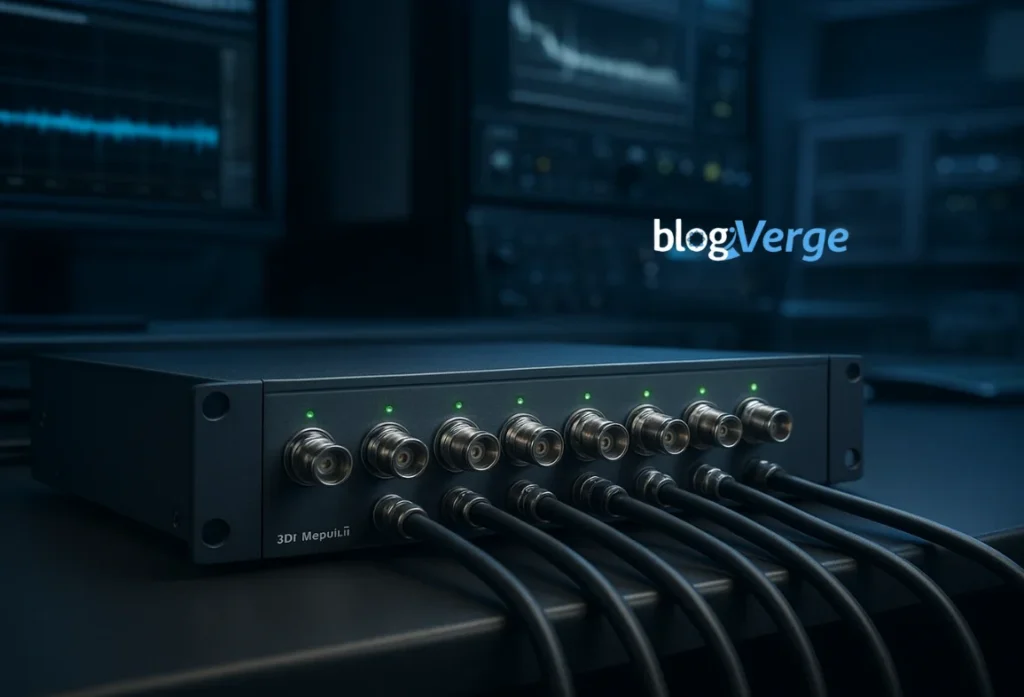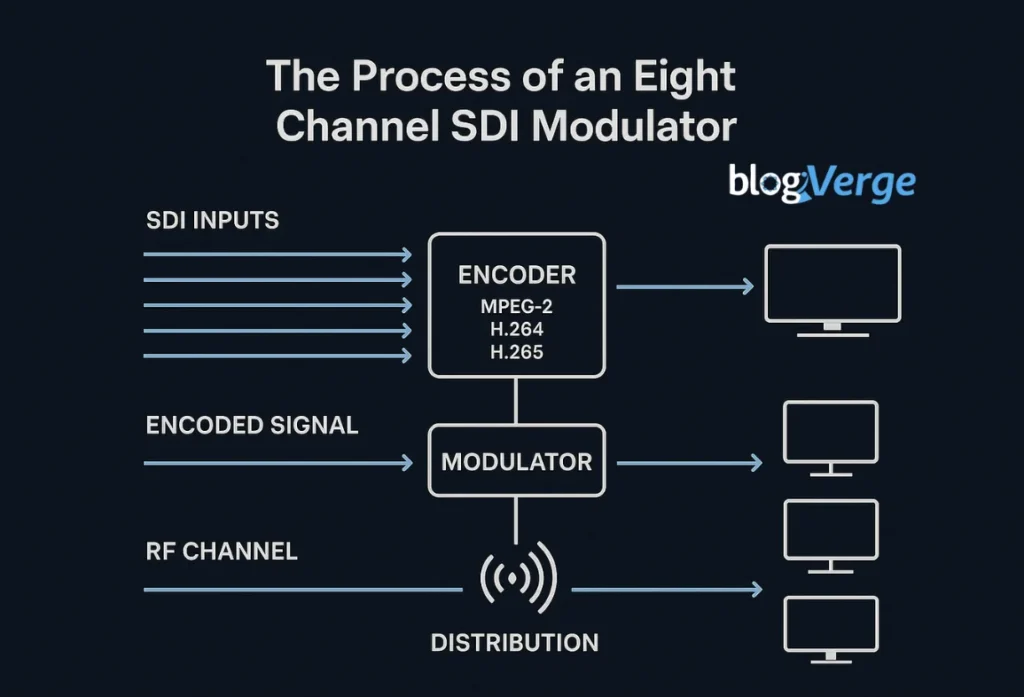There is an unseen hand in the television sets of all hotel rooms, the displays of stadiums, or the monitors of control rooms that is purported to ensure the facilitation of a simple and quality video transmission on the 8 channel SDI modulator. It is not a glamorous sound, but once again, such a machine is the beat of professional broadcasting and mass delivery of video. It can pass up to eight SDI video signals, converting them to RF or cochannels that can be transmitted through the existing cable infrastructure. There is a lot of sophistication enveloping such an elementary role.
The SDI modulator is an 8 channel SDI modulator that incorporates precision in engineering, stability, and adjustability. For instance, consider a live sporting broadcast that requires transmitting eight camera angles to hundreds of screens simultaneously. Alternatively, we could feel a hospital that utilizes internal video networks to provide patient information and training. No 8 channel SDI broadcasts would be sync-co-ordinated without an 8 channel SDI modulator.
The 8 channel SDI modulator not only implies a hardware acquisition but also ensures flawless communication to engineers and broadcasters. It discusses the difference between the unaltered sound of SDI and the coverage area of coaxial broadcasting. This device has become a silent hero in an era of efficiency, scalability, and perfection, delivering each pixel and frame to its audience flawlessly.
Table of Contents
What Exactly Is an 8 Channel SDI Modulator?
An 8 channel SDI modulator is professional broadcasting equipment that converts up to eight SDI (Serial Digital Interface) inputs into RF signals. These RF signals can be subsequently transmitted with the help of coaxial cables towards multiple TVs or receivers. It is ideally suited for environments such as broadcast stations, hotels, stadiums, hospitals, and campuses, where numerous video feeds need to be distributed efficiently.
Ideally, the 8 channel SDI modulator will not require multiple individual modulators. Instead of managing eight individual boxes, engineers can handle a single device that performs eight different conversions simultaneously. This method saves space, and it consumes less power, making it less cumbersome to maintain.
The SDI inputs can all carry the high-definition video, embedded audio and even metadata like time codes or captions. These signals are then coded with the 8 channel SDI modulator, which is used to transmit them to TV channels at specific RF frequencies. Several standards of modulation may be supported by other advanced models, including QAM, DVB-T, ATSC, or ISDB-T, allowing them to be adapted to the diverse broadcast systems across the world.
Such flexibility implies that a specific unit can be implemented in a wide range of applications. The 8 channel SDI modulator is most efficient and reliable in the broadcasting of active sports events, working of hotel entertainment networks, or in the provision of surveillance channels.

The Process of an eight-channel SDI Modulator?
It might not be easy to say so, but there are more straightforward rules that exist on the surface and control the inner mechanism of an 8 channel SDI modulator. Video of each of the SDI inputs is compressed in an encoder (with MPEG-2, H.264 or H.265). The signal is then modulated in an RF channel, a Process known as encoding, and subsequently distributed.
Suppose that it is converting eight digital video rivers into eight linear TV streams. They are all connected as one, on the same coaxial network. Other advanced modulators enable the user to set up the parameters of each channel, e.g. the bitrate, frequency and type of modulation, which gives quality and bandwidth control.
The SDI modulators have eight channels, which can be hybridized, i.e. every channel may receive either SDI or HDMI. The device offers flexibility in mixing input types from live events or production facilities. Support for professional SDI cameras and consumer HDMI devices in independent units may have been previously supported, which would have saved time and hardware resources.
Even the high-end models are also available with remote manageability, either through the use of web interfaces or SNMP, to allow the engineering personnel to monitor the performance, diagnose faults, and make changes to the channels in real-time. These devices enable the 8 channel SDI modulator to function as both a converter and an overall signal handling platform.

Modulators 8 Channel SDI Uses
It is what leads to the current broadcasting environment, making the 8 channel SDI modulator a necessity. These are some of the efficient examples of how and where it glitters:
Broadcast Centres and Cable Ends.
Television stations and cable providers use these modulators to broadcast multiple HD feeds simultaneously. The 8 channel SDI modulator streamlines the playout system, eliminating the need for various devices to ensure stable transmission.
Hospitals, Hotels and Campuses.
These are the places that usually deliver videos in-house using coax networks. They do not need to deploy a new IP infrastructure. Nevertheless, they can employ an 8 channel SDI modulator to force the training videos, announcements, or entertainment to be delivered directly into the in-room televisions.
Stadiums and Large Venues
The dozens of screens used at sports events and concerts display alternative camera work and advertisements in real-time. These feeds are transmitted to the 8 channel SDI modulator, which is then transmitted with reduced delay, and in effect, real-time synchronization between thousands of viewers is achieved.
Security and Surveillance
Many SDI camera feeds of sensitive installations can be converted to RF signals that can be viewed on regular TV sets. This yields a stable, low-latency viewing infrastructure that does not require the sophistication of IP video streaming.
Live Implementation Process and Demo
To have a feel of it, the following modulator hybrid SDI / HDMI tutorial on YouTube may be useful:
The presenter in this video presentation shows how to operate the eight HD-SDI inputs, configure the modulation frequencies and allocate signals in a television network. The simplicity of the installation is a compliment to the simplistic nature of the Process enabled by an 8-channel SDI modulator of good quality.
A good example would be the Thor Hybrid 8 Modulator, which is capable of accepting SDI and HDMI and can fully support QAM and ATSC. The second is the VeCOAX Ultra 8 SDI Modulator, which is reported to be of a very high standard in signal quality, besides having easy integration with the already established coax networks.
Conclusion
Most video systems depend on the eight-channel SDI modulator, which would be silent. It combines the quality of professional SDI with the ease of coaxial distribution, making it essential to broadcasters, hospitality, stadiums, and colleges. It eliminates downtimes, loss of synchronization and quality problems. It also ensures that whatever you send, whether in messages, entertainment, or live shows, reaches our viewers smoothly.
No matter what the content of the digital world is, all that matters is the speed and reliability, and that is precisely what a properly designed 8-channel SDI modulator has to provide. When considering a new headend or upgrading an existing system, focus on the long-term benefits. It is the most critical technology that helps make your video network successful.
FAQs
Q1: What is the benefit of an eight-channel SDI modulator as compared to multiple units of single-channel modulators?
It is a combination of eight independent modulators in one chassis, which is a compact and power-efficient complex, and it is also centrally controlled.
Q2: Does it possess an eight-channel SDI modulator that is compatible with SDI and HDMI?
Ans: Current models have hybrid ports too, which can be operated in either mode with greater freedom in the selection of the source of the signal.
Q3: What do you feel is the most excellent use of an eight-channel SDI modulator?
Ans: Any environment that involves distributing several HD video streams through coax, such as hotels, stadiums and centres.
Q4: Is latency a concern?
Good Goodlators are characterized by low-latency encoding, which enables real-time performance, especially in live events.
Q5: Can it be managed and controlled in any way?
Ans: Yes, most professional models can be monitored using web dashboards or SNMP, and also configured and firmware updated remotely.

